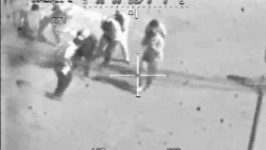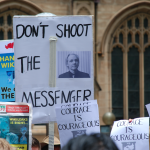Indiscriminate Slaughter: The Leaks that Led to the Targeting of Assange

Right now, Julian Assange is languishing in south London’s Belmarsh maximum security prison. He’s facing up to 12 months inside for breach of bail. And he’ll appear in Westminster Magistrates Court via video link on 2 May for a hearing related to his possible extradition to the US.
It’s common knowledge that US authorities are pursuing Assange over the publication of classified US government documents. However, the charge the US hope to extradite the Australian journalist on is one count of conspiracy to commit computer intrusion.
The decision to pursue a hacking charge is hardly surprising though, as following former Australian PM Julia Gillard referring to Assange’s activities as “illegal” back in 2010, the AFP found it couldn’t identify that he’d committed any offence where Australia would have the jurisdiction to prosecute.
And while the US has decided it has jurisdiction to pursue a hacking offence allegedly attempted on foreign soil, it seems it was the 2011 musings of then Senator George Brandis in regard to Assange’s possible involvement in soliciting leaks that led US authorities to take this avenue.
So, it’s an opportune time to take a look at the 700,000-odd classified, or highly-sensitive, military and diplomatic documents that Chelsea Manning passed onto Wikileaks – some of which were on a compact disc marked “Lady Gaga”- that led US authorities to want to punish Assange.
Indiscriminate slaughter
Collateral Murder is a 39 minute US military video that shows a series of air-to-ground attacks carried out by US troops in two Apache helicopters on 12 July 2007. Released in April 2010, the clip shows the indiscriminate killing of eleven Iraqi men, including two Reuters news outlet staff.
After the initial gunning down of the men – some of whom were armed – a chopper hovers as the soldiers watch 40-year-old Reuters camera assistant Saeed Chmagh crawling injured on the roadside. When unarmed men from a passing van try to help him, the soldiers fire down upon them.
The release of the footage led to questions about the actions of US forces in foreign lands and what goes undisclosed. It also marked a change for Wikileaks, as the footage was edited down to a 17 minute clip, with content added in journalistic style, rather than its usual publishing of raw content.
A stark comparison
The Afghan War Logs comprise of close to 92,000 documents produced between 2004 and 2009. As Der Spiegel outlined on their release in July 2010, never before had “it been possible to compare the reality on the battlefield” to what “the US Army propaganda” machine propagates.
The leaking of these files exposed details about the secretive Task Force 373: a troop of US elite soldiers. This included one particularly heinous file marked “keep protected”, which described a 2007 operation to take out a prominent al-Qaida figure, which resulted in the killing of six children.
Then Obama administration deputy national security advisor Ben Rhodes condemned the disclosure of the classified documents, asserting that it endangered the lives of US personnel and that of allied nations, as well as threatening US national security.
The civilian toll
Published in October 2010, the Iraq War Logs is made up of 391,831 files from 2004 to 2009. The documents detail 109,000 deaths recorded as a result of the imperialist war in Iraq, of which 66,081 were civilian casualties.
Sydney Criminal Lawyers randomly selected one file, which details that two improvised explosive devices were placed under bleachers at a soccer field in Al Mammon Zone. As locals watched a game, the bombs were detonated on 2 August 2006, leaving eight civilians dead and 13 injured.
The war logs also detail numerous cases of routine detainee abuse by Iraqi police and soldiers, which is supported by medical evidence. There are incidents of shackled prisoners being blindfolded and hung by their wrists or ankles, as well as whipping, punching and the use of electric shock torture.
A diplomatic nightmare
Cablegate involved the November 2010 release of 251,287 classified cables sent to the US State Department between 1966 and 2010 from 274 consulates, embassies and diplomatic missions around the globe. At the time, it was the largest leak of confidential documents in history.
And what was divulged was the United States painstakingly maintaining its influence in the affairs of other nations, as well as detailed accounts of how foreign players were being perceived by the White House and its diplomats.
It was revealed the US was spying on its allies and the UN, it couldn’t close Guantanamo as no other nations would take the detainees, while then US secretary of state Hillary Clinton asked diplomats to keep an eye on then Argentinean president Cristina Fernandez in case she was on meds.
Detained for no crime
The Gitmo Files were released on 24 April 2011. The leak was made up of 779 secret files from the Guantanamo Bay prison camp. The documents were the last of those that had been passed on by Manning, who by that stage had long been detained by US authorities.
The files revealed that while dozens of confessed terrorists were being held at Guantanamo, there were more than 150 innocent Afghan and Pakistani nationals under long-term detention there. And the US had held men as old as 89 at the camp, while boys as young as 14 had been imprisoned.
The threat to journalism is real
Assange has been charged with attempted hacking under the US Computer Fraud and Abuse Act (CFAA). This carries a maximum of five years imprisonment. But, his long-time legal adviser Geoffrey Robertson has stated that his client could be subsequently charged with other offences adding up to 45 years.
Electronic Frontier Foundation executive director Cindy Cohn has explained that the alleged crime involved “an unsuccessful attempt to reverse engineer a password”. And it’s long been disputed whether a chat between Manning and an unidentified individual referred to any such attempt.
Cohn said that the charge doesn’t – as some have implied – reveal that the US government isn’t targeting journalists. Indeed, she makes clear that references to “journalistic techniques” irrelevant to the offence are detailed in the indictment as if they’re somehow related to the crime.
The lawyer further points out that it’s impossible to consider the relatively minor charge that the US government is trying to extradite him on without considering the almost decade-long effort it’s made to try and find a way to punish Assange for publishing its classified documents.
“Anyone concerned about press freedom should be concerned about this application of the CFAA,” Ms Cohn warns. And she agrees the charge of attempted hacking “might not be the only charge Assange ultimately faces”.







